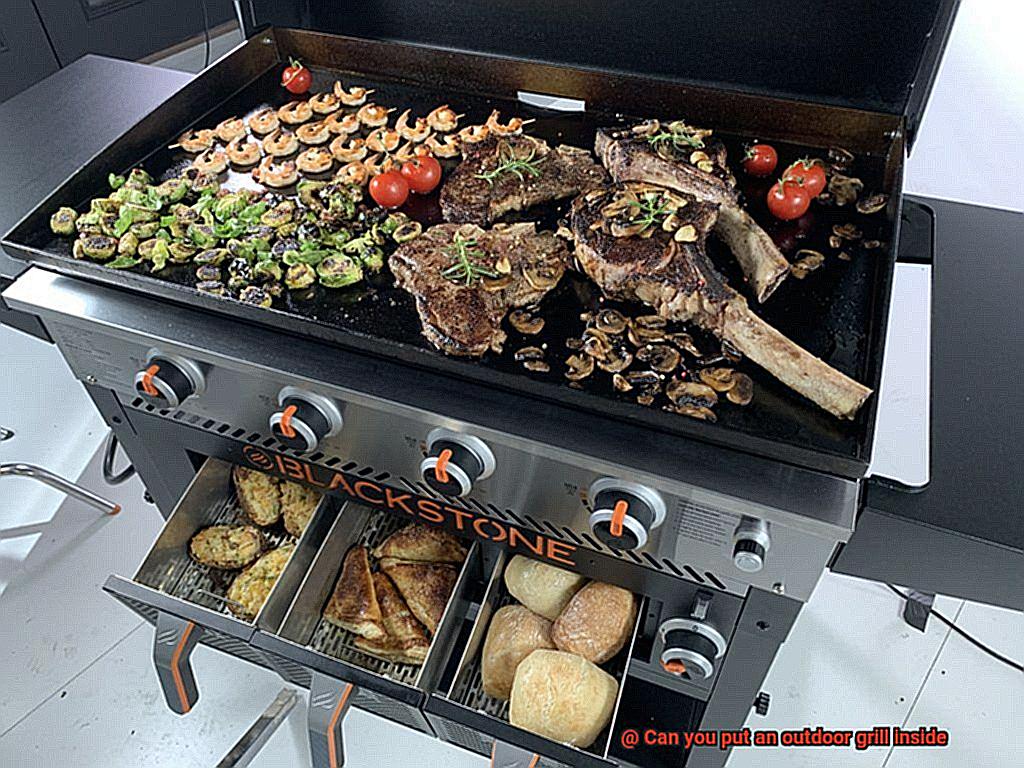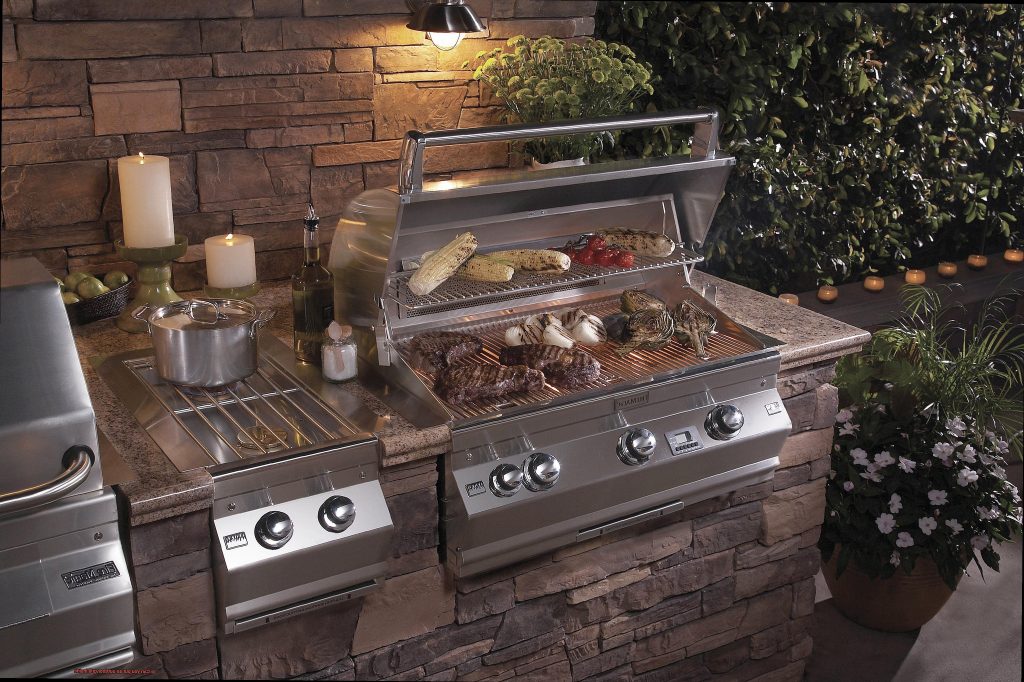Do you crave that smoky, juicy flavor that only comes from cooking on an outdoor grill? But what if the weather is bad, or you don’t have enough outdoor space, or you just don’t feel like dealing with the hassle of setting up and cleaning an outdoor grill? Can you bring that beloved outdoor grill inside? Well, it’s not a straightforward answer.
Let’s get one thing straight: indoor grilling is not the same as outdoor grilling. Indoor grills are usually electric or gas-powered, which means they lack the intense heat and smoke of charcoal or wood-fired grills. Plus, indoor grilling can produce a lot of smoke and fumes, which can be dangerous if not properly ventilated.
So what’s the verdict? Can you put an outdoor grill inside? The short answer is yes, but there are some important caveats to consider. In this blog post, we’ll explore the pros and cons of indoor grilling, the different types of indoor grills available, safety considerations to keep in mind, and tips for making your indoor grilling experience successful. By the end of this post, you’ll know whether indoor grilling is right for you and how to do it safely and effectively.
Contents
What is an Outdoor Grill?
An outdoor grill is more than just a cooking appliance; it’s a symbol of summertime, backyard barbecues, and family gatherings. The allure of an outdoor grill lies in its ability to cook food over an open flame or hot coals, imparting a smoky flavor that’s hard to replicate with other cooking methods.
Outdoor grills come in a wide range of shapes and sizes, from small portable charcoal grills to large built-in gas grills. They’re perfect for use during warm weather months, allowing you to cook food outside and keep your home cool. Burgers, hot dogs, vegetables, and seafood are just a few examples of the many foods that can be cooked on an outdoor grill.
Safety is paramount when using an outdoor grill. It’s essential to keep flammable materials away from the grill and to use long utensils to avoid burns. Supervision is also crucial while the grill is in use, especially if children or pets are present. Regular cleaning of the grill is also necessary to prevent grease buildup, which can increase the risk of fire.
While some may be tempted to bring their outdoor grill inside for convenience or inclement weather, doing so is not recommended due to the potential health and safety risks involved. Instead, consider investing in an electric indoor grill or finding other alternatives for indoor cooking.
Are Outdoor Grills Safe for Indoor Use?
While the thought of cooking up a storm on your outdoor grill indoors may seem tempting, it’s important to put safety first. One question that arises is whether outdoor grills are safe for indoor use. The answer is a resounding no.
Outdoor grills are specifically designed for outdoor use and emit carbon monoxide, a toxic gas that can quickly build up in enclosed spaces like a kitchen or garage. Carbon monoxide inhalation can lead to various health issues, including headaches, dizziness, nausea, and even death in extreme cases.
Furthermore, using an outdoor grill indoors can also pose a fire hazard. The propane or charcoal fuel sources can create flames and embers that can easily ignite nearby objects in an indoor space. This is a recipe for disaster and could lead to severe damage to your home or injury to yourself and others.
Now, you might be wondering if an indoor grill is a safer option. Indeed, there are indoor grills available that are electric and do not emit carbon monoxide or flames. However, it’s still crucial to use them in well-ventilated areas and follow all safety guidelines to avoid any potential hazards.
Potential Health Risks of Using an Outdoor Grill Indoors

Grilling is an American tradition that brings people together and tantalizes their taste buds. However, when the weather turns chilly, some people might consider using their outdoor grill indoors. Although it may seem like a convenient solution, it can pose potential health risks that should not be ignored.
One of the most significant risks of indoor grilling is carbon monoxide poisoning. When fuels such as propane or charcoal are burned, they produce an odorless, colorless gas called carbon monoxide. In an outdoor setting, this gas can dissipate into the air, but in an indoor environment, it can build up quickly and become lethal. Symptoms of carbon monoxide poisoning include headache, dizziness, nausea, and confusion. In severe cases, it can lead to unconsciousness and even death.
Another risk of indoor grilling is the release of harmful chemicals into the air. When meat is cooked at high temperatures, it can produce carcinogens such as heterocyclic amines (HCAs) and polycyclic aromatic hydrocarbons (PAHs). These chemicals can be detrimental to human health and have been linked to an increased risk of cancer. When grilling is done indoors, these harmful chemicals can accumulate in the air and be breathed in by those in the area.
Moreover, using an outdoor grill indoors can also be a fire hazard. Grills are designed for outdoor use where there is adequate ventilation and space to prevent fires. Indoors, there may not be enough space for the grill or proper ventilation to prevent fires from starting.
Therefore, it is highly recommended not to use an outdoor grill indoors due to the potential health risks and fire hazards involved. However, if you must grill indoors, ensure that there is proper ventilation and that the grill is placed away from flammable materials. It is also advisable to invest in a safe indoor grill specifically designed for indoor use. These grills are equipped with safety features that minimize the risks associated with indoor grilling.
Ventilation Considerations for Indoor Grilling
Indoor grilling is a tantalizing option when the weather outside is less than ideal. However, before you start cooking up a storm, it’s crucial to remember that proper ventilation is essential to keep your home safe. Grilling produces smoke that can quickly fill up a room and trigger smoke alarms, causing health hazards and potential damage to your house. Here are some important considerations for ventilation when it comes to indoor grilling.
Location Matters:
Choosing the right location for your grill is the first step in ensuring proper ventilation. Ideally, you should place it near a window or door that can be opened to allow fresh air to circulate. This not only helps eliminate smoke but also reduces fire hazards.
Exhaust Hoods are Crucial:
Using an exhaust hood directly above the grill is another way to improve ventilation. The hood captures the smoke and directs it outside. It’s essential to ensure that the hood has enough airflow capacity and is installed correctly to avoid any potential hazards.
Fans Help Circulate Air:
In addition to using an exhaust hood, fans can help improve air circulation. They move smoke towards the exhaust hood and away from other areas of your home. Consider using a ceiling fan or portable fans to help distribute the air more effectively.
Clean Your Grill Regularly:
Another important factor in ensuring proper ventilation is cleaning your grill regularly. A dirty grill can cause increased smoke production, leading to health hazards and potential damage to your home. Regular cleaning will help ensure that your grill functions correctly and does not produce excessive smoke.
Fire Safety with Indoor Grilling
Indoor grilling is a fantastic way to cook up your favorite dishes, but it’s crucial to prioritize fire safety. Grilling indoors poses a higher risk of starting a fire due to the close proximity of flammable materials such as curtains, furniture, and walls. However, with the right precautions, you can enjoy indoor grilling safely and without worry.
Here are some essential fire safety tips for indoor grilling:
- Choose the right grill: Electric or infrared grills are safer options for indoor use as they don’t produce flames or emit harmful gases. If you prefer a gas or charcoal grill, ensure that it’s specifically designed for indoor use and has proper ventilation.
- Keep an eye on your grill: Never leave your grill unattended, even for a few minutes. Always keep a fire extinguisher nearby in case of an emergency.
- Select the right location: Place your grill on a stable and non-flammable surface away from any combustible materials. Ensure that there’s adequate ventilation in the area, and never grill near an open window or door.
- Clean your grill regularly: Grease buildup can easily ignite and start a fire. Follow the manufacturer’s instructions for cleaning and maintenance to prevent this.
It’s important to note that while following these tips is necessary for fire safety, accidents can still happen. For this reason, having working smoke detectors and an escape plan in place is crucial.
Electric Grills as a Safer Alternative to Gas or Charcoal Grills
Electric grills are the perfect solution for indoor grilling, providing a safer alternative to gas or charcoal grills. As an expert on the topic, I can assure you that electric grills are the way to go.
One of the primary benefits of electric grills is that they don’t emit harmful gases or chemicals, which can pose potential health risks. This makes them an ideal option for indoor grilling, where proper ventilation and air quality are paramount.
Moreover, electric grills are much safer than gas or charcoal grills when used indoors. Carbon monoxide poisoning is a serious concern with gas or charcoal grills, as these fuels produce dangerous levels of carbon monoxide. With electric grills, however, there’s no need to worry about this risk.
Electric grills come in a variety of sizes and styles, from compact tabletop models to larger stand-alone units. They operate by using electricity to heat up the cooking surface, eliminating the need for gas or charcoal. Furthermore, electric grills are incredibly easy to clean and maintain, making them an ideal choice for indoor use.
When selecting an electric grill for indoor use, consider a model that is appropriately sized for your space. Adjustable temperature controls and non-stick cooking surfaces are also essential features to look for. Finally, always follow the manufacturer’s safety instructions and never leave your grill unattended while in use.
Basic Safety Guidelines for Using an Electric Grill Indoors
It’s crucial to follow some basic safety guidelines to ensure that your indoor grilling experience is both safe and enjoyable.
To start with, always make sure to use your electric grill on a stable and heat-resistant surface. This can be a countertop or table specifically designed for electric grills. It’s best to avoid using the grill on wooden surfaces or near any flammable materials such as curtains or papers. A stable surface will prevent any accidents caused by a wobbly grill, while a heat-resistant one will save you from any burns caused by hot surfaces.
In addition, proper ventilation is key when it comes to indoor grilling. Electric grills give off smoke and fumes that can cause respiratory problems if inhaled in large amounts. Make sure to open windows or use a vent hood to prevent these fumes from accumulating in the room. This will also help keep your indoor air quality in check.
Another crucial point is never leaving your grill unattended while it’s in use. This is especially important when grilling indoors since there’s a higher risk of fire or accidents due to the proximity of flammable materials. Keep an eye on your grill at all times and make sure that nothing is too close to it.
Lastly, always make sure that your grill is turned off and cooled down before storing it away. This will prevent accidental fires or damage to the grill itself. It’s essential to let it cool down completely before storing it, as hot surfaces can cause damage or even start a fire.
Alternatives for Indoor Cooking
There are a plethora of alternatives for indoor cooking that can provide similar results to outdoor grilling.
Firstly, consider using a stovetop griddle. This versatile tool allows you to cook a variety of foods such as pancakes, burgers, and vegetables to perfection. With its ability to sear, you’ll get that delicious crispiness in your food that outdoor grilling provides.
Another great option is the cast iron skillet. This kitchen staple allows for searing, sautéing, and even baking your favorite dishes. Whether you’re cooking meat or vegetables, a cast iron skillet will ensure that your food is cooked to perfection every time.
For those who love the taste of grilled food but don’t have access to an outdoor grill, an indoor electric grill is a fantastic option. These grills come in various sizes and styles and can be used to cook everything from burgers to seafood. You’ll be able to enjoy the same delicious flavors as outdoor grilling without having to step outside.
If you’re looking for a way to smoke your food indoors, consider investing in a smoker oven. These indoor options allow for smoking meat and vegetables without the need for an outdoor space. You’ll achieve that smoky flavor without having to brave the elements or invest in an outdoor smoker.
Finally, if you’re looking for a quick and easy way to achieve that smoky flavor without investing in an indoor grill or smoker, turn to the trusty grill pan. These pans feature raised ridges that allow excess grease to drip away while creating a similar effect to outdoor grilling. You’ll be able to cook up your favorite dishes with ease.
9HQy3lvyFXE” >
Conclusion
In conclusion, the thought of bringing an outdoor grill inside may seem appealing, but it’s not worth risking your health and safety. Carbon monoxide emissions and fire hazards are just a few examples of the potential dangers that come with indoor grilling.
However, fear not. There are plenty of alternatives for indoor cooking that can provide similar results to outdoor grilling. Electric grills are an excellent option as they emit no harmful gases or chemicals and come in various sizes and styles. Plus, they’re incredibly easy to clean and maintain.
When using an electric grill indoors, make sure to follow basic safety guidelines such as placing it on a stable surface, ensuring proper ventilation, never leaving it unattended while in use, and allowing it to cool down before storing.
But wait, there’s more. Stovetop griddles, cast iron skillets, smoker ovens, and grill pans are just a few other options for achieving those delicious grilled flavors and textures indoors.
In summary, whether you opt for an electric grill or explore other indoor cooking alternatives, remember that safety should always be your top priority.






